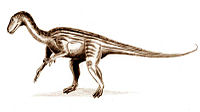1836 in paleontology
| |||
|---|---|---|---|
| +... |
Paleontology or palaeontology is the study of prehistoric life forms on Earth through the examination of plant and animal fossils.[1] This includes the study of body fossils, tracks (ichnites), burrows, cast-off parts, fossilised feces (coprolites), palynomorphs and chemical residues. Because humans have encountered fossils for millennia, paleontology has a long history both before and after becoming formalized as a science. This article records significant discoveries and events related to paleontology that occurred or were published in the year 1836.
Dinosaurs
Newly named dinosaurs
| Taxon | Novelty | Status | Author(s) | Age | Unit | Location | Notes | Images |
|---|---|---|---|---|---|---|---|---|
|
Gen. et sp. nov. |
Junior synonym, Preoccupied genus |
The name was preoccupied by a non-dinosaurian archosaur named by Geoffroy Saint-Hilaire in 1833. The genus and both species are now considered to be junior synonyms of Thecodontosaurus antiquus.[2] |
||||||
|
Gen. nov. |
Valid |
Henry Riley, Samuel Stutchbury |
Durdham Down[2] |
Thecodontosaurus is the fourth valid dinosaur genus named, (although if the dubious Streptospondylus and Macrodontophion are included, it would be the sixth). It was first excavated by Riley and Stutchbury in 1834, and they published a preliminary description in 1835. When they assigned the remains to a new taxon, which they named Thecodontosaurus, they did not assign a species, which was later named as T. antiquus by Morris. The genus was not originally recognized as a dinosaur, with Riley and Stutchbury finding it a saurian, and Richard Owen a thecodontian. Only in 1870 did Thomas Huxley identify the material as dinosaurian. Another genus also named by Riley and Stutchbury in 1836, Palaeosaurus, is now considered a synonym of Thecodontosaurus.[2] |
See also
References
- ^ Gini-Newman, Garfield; Graham, Elizabeth (2001). Echoes from the past: world history to the 16th century. Toronto: McGraw-Hill Ryerson Ltd. ISBN 9780070887398. OCLC 46769716.
- ^ a b c d e f Benton, M.J.; Juul, L.; Storrs, G.W.; Galton, P.M. (2000). "Anatomy and Systematics of the Prosauropod Dinosaur Thecodontosaurus antiquus from the Upper Triassic of Southwest England". Journal of Vertebrate Paleontology. 20 (1): 77–108. doi:10.1671/0272-4634(2000)020[0077:aasotp]2.0.co;2. JSTOR 4524065.
- ^ Riley, H.; Stutchbury, S. (1836). "A description of various fossil remains of three distinct saurian animals discovered in the three district saurian animals discovered in the autumn of 1834, in the magnesian conglomerate on Durdham Down, near Bristol". Proceedings of the Geological Society of London. 2: 397–399.



